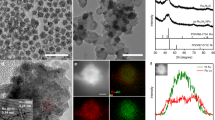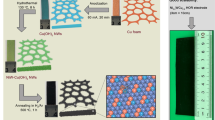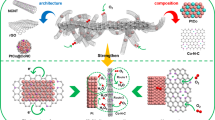Abstract
HYDROCARBON fuels (methane, propane and so on) are relatively inert and can only be electrochemically oxidized using either high loading noble metal-black electrodes in phosphoric acid at 150° C or high temperature molten carbonate (or solid oxide) electrolyte cells at 600–1,000° C (ref. 1). Alternatively the fuel may be “reformed”, producing impure hydrogen (containing carbon dioxide and some carbon monoxide) which may be fed into a low temperature (> 100° C) acid fuel cell. Carbon monoxide, however, poisons platinum black by strongly adsorbing on its surface (with high coverage) at normal fuel cell anode potentials. Little opportunity exists for water molecules to adsorb on sites adjacent to surface CO molecules—a necessary condition for the removal of the latter by anodic oxidation2 
This is a preview of subscription content, access via your institution
Access options
Subscribe to this journal
Receive 51 print issues and online access
$199.00 per year
only $3.90 per issue
Buy this article
- Purchase on Springer Link
- Instant access to full article PDF
Prices may be subject to local taxes which are calculated during checkout
Similar content being viewed by others
References
Tantram, A. D. S., Tseung, A. C. C., and Harris, B. S., in Hydrocarbon Fuel Cell Technology (edit. by Baker, B. S.), 187 (Academic Press, 1963).
Gilman, S., J. Phys. Chem., 68, 70 (1964).
Niedrach, L. W., and Weinstock, I. B., Electrochem. Tech., 3, 270 (1965).
Benson, J. E., Kohn, H. W., and Boudart, M., J. Catalysis, 5, 307 (1966).
Glemser, O., and Naumann, K., Z. Anorg. Chem., 265, 288 (1951).
Dickens, P. G., and Hurditch, R. J., Nature, 215, 1266 (1967).
Frumkin, A. N., and Aikazyan, E. A., Izvest. Akad. Nauk. SSSR Otdel. Khim. Nauk, 202 (1959).
Makowski, M. P., Heitz, E., and Yeager, E., Office of Naval Research, Tech. Rep. No. 19 (1964).
Giner, J., Parry, J., Swette, L., and Cattabriga, R., NASA Eighth Quart. Rep. (1965–67).
Wakkad, S. E. S., Rizk, H. A., and Ebaid, E. G., J. Phys. Chem., 59, 1004 (1953).
Lavrenko, V. A., Zhur. Fiz. Khim., 35, 1095 (1961).
Stalica, N. R., Diss. Abst., 24 (12), 4954 (1964).
Author information
Authors and Affiliations
Rights and permissions
About this article
Cite this article
HOBBS, B., TSEUNG, A. High Performance, Platinum Activated Tungsten Oxide Fuel Cell Electrodes. Nature 222, 556–558 (1969). https://doi.org/10.1038/222556a0
Received:
Revised:
Issue Date:
DOI: https://doi.org/10.1038/222556a0
This article is cited by
-
A review article based on composite graphene @tungsten oxide thin films for various applications
Tungsten (2023)
-
Advanced Noncarbon Materials as Catalyst Supports and Non-noble Electrocatalysts for Fuel Cells and Metal–Air Batteries
Electrochemical Energy Reviews (2021)
-
Dual synergetic catalytic effects boost hydrogen electric oxidation performance of Pd/W18O49
Nano Research (2021)
-
Selective electrocatalysis imparted by metal–insulator transition for durability enhancement of automotive fuel cells
Nature Catalysis (2020)
-
Preparation of PtRu/WO3–C by intermittent microwave method with enhanced catalytic activity of methanol oxidation
Journal of Applied Electrochemistry (2016)
Comments
By submitting a comment you agree to abide by our Terms and Community Guidelines. If you find something abusive or that does not comply with our terms or guidelines please flag it as inappropriate.



